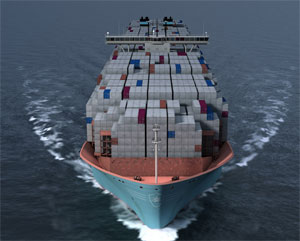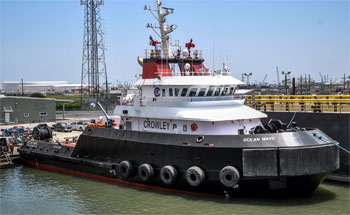Today’s maritime industry is entering the age of the green ship.
“The key elements of green ship design can be boiled down to the vessel’s carbon footprint,” said Douglas Wolff, director of engineering at Foss Maritime Co. in Seattle.
Foss plans to build three Arctic-class tugs, which will broaden the company’s capacity to take on large oil and gas exploration projects in extreme environments. The design goals include maximizing fuel efficiency and minimizing environmental impact.
“Certainly the design engineers need to consider other elements, such as waste water, deck runoff and acoustic signature, both above and below water; but public opinion, regulatory demands and operational costs all push the designer and operator to focus on the carbon footprint,” Wolff said. “For vessels operating in U.S. waters, compliance with the EPA Tier 2, Tier 3 and Tier 4 will drive capital costs for new vessels, and eventually maintenance and repair budgets for existing vessels. One of the positive outcomes is the significant reduction in harmful emissions.”
 |
|
Brian Gauvin Ocean Wave is designed to be able to incorporate new emissions technology that will permit upgrading its Caterpillar Tier II engines to Tier III or Tier IV. |
Naval architects and ship designers are constantly seeking new and efficient ship designs and products in every system and piece of equipment. As technologies mature, product offerings become more cost effective. “Aside from these big-picture issues, naval architects are constantly reviewing new products to determine if their application can increase efficiency,” Wolff said. “The rapidly increasing use of LED lighting fixtures is a case in point. This technology has finally matured so that the units are less expensive than traditional incandescent and fluorescent to install and maintain, and they offer significant reduction in power consumption.”
There are many examples of ships being built that incorporate green designs or green technologies. Foss Maritime now has two hybrid tugs, Carolyn Dorothy and Campbell Foss, both based in Southern California. A third tug, Alta June, is scheduled to be converted to hybrid operation later in 2013.
“The Carolyn Dorothy was the world’s first hybrid tug,” Wolff observed, “and the sequential conversion of the other two vessels has allowed the Foss engineering staff to refine the hybrid design, making it simpler and more efficient while improving reliability and reducing maintenance requirements.”
Foss is not the only tug company to invest in sustainable designs. Bollinger Shipyards in Louisiana recently completed construction of Ocean Wave for Crowley Maritime. The vessel is the first of Crowley’s Ocean-class tugs. The twin-screw vessel is designed with controllable-pitch propellers in nozzles with independent high-lift rudders for maneuverability and propulsion efficiency.
The vessel has key environmental attributes designed to keep any pollutants out of surrounding waters. The hull is welded steel. All tanks containing oil and oil traces are located inboard of the side shell, creating a double hull to prevent spills in the event of collision. The vessel is also designed for zero discharge of any machinery cooling, gray or black water to further safeguard the environment.
“Taking delivery of this first Ocean-class tug is a significant milestone for Crowley and our customers who will benefit from its use on their projects,” said Tom Crowley, the company’s chairman, president and chief executive. “These Jensen Maritime-designed towing vessels — three of which are under construction at Bollinger — are a new generation of powerful, high-tech and environmentally friendly workhorses for Crowley that will further solidify our standing as an industry leader in ocean towing, salvage and offshore marine support for the upstream energy industry.”
The big container lines are also focused on green ship design. Maersk Line recently contracted for 10 vessels costing $190 million each to transport goods between Asia and Europe. These vessels — known as the Triple-E ships for economy of scale, energy efficiency and environmentally improved — are intended to demonstrate that new containerships can be built with a sustainable design.
Per container, the ships will emit 50 percent less CO2 than the industry average on the Asia-Europe trade lanes.
About $30 million of the price tag of the new vessels was dedicated to make them the “most energy-efficient (container vessel) that the world has ever seen.” The ships’ energy consumption and carbon output will be half the industry average for vessels serving Asia-European trade and 20 percent lower than the previous best in that group, Emma Maersk.
New vessel design includes a waste-heat recovery system that reduces fuel consumption and CO2 emissions by 9 percent. The design also designates space to accommodate sulfur-cleaning scrubbers to be retrofitted to the vessels at a later time.
 |
|
Courtesy Maersk Line A rendering of one of Maersk’s new Triple-E ships. The company has ordered 10 of the vessels costing $190 million each. They are expected to emit 50 percent less CO2 per container carried compared with the industry average. The innovations include a waste heat recovery system that will cut fuel consumption by 9 percent. |
Unique to the design is a “passport” method of documenting components of the ships’ construction so materials may be recycled or reused in the construction of the next generation of vessels.
The cruise industry is also adopting green design. Cruise vessels are in the public eye and that exposure means that operators of green vessels can project an image of being good environmental stewards while improving their bottom lines.
Viking River Cruises for example, is a company that offers river cruises in Europe and other parts of the world. It added a green ship to its river cruise fleet in 2010. The vessel has a propulsion system that is both efficient and quiet. “Viking Legend’s diesel engine propels a generator that supplies the ship’s electrical systems,” explained Viking’s Vice President of Nautical Operations Thomas Bogler. “At any given moment the ship’s energy needs are automatically calculated and the engines produce and supply only as much energy as needed. This allows the ship to use 20 percent less energy than a comparable ship.”
The new ship will also provide a quieter ride for guests by using four smaller propellers instead of two large ones. The new propulsion system offers additional benefits. “The diesel engine is smaller than a conventional engine, so it vibrates less, making it very quiet,” Bogler said. The propulsion system includes three diesel generator-sets: two rated 1,000 kW and one rated 560 kW. System integration permits the vessel to operate on just two of the diesel-generator sets.
“The system also allows us to continue cruising even if one of the engines has to be taken off line for scheduled maintenance — remaining engines will simply produce more output to compensate,” Bogler said.
Viking River Cruises is the first to introduce this main propulsion technology to European river cruises. It consists of four electrically driven Schottel rudder propellers (azimuthing drives). The propulsion system also includes two electrically driven pump jets which serve as bow thrusters but can also provide emergency propulsion.
The vessel has a top speed of about 11 knots. It would ordinarily require 1,600 kW to reach this speed, but the vessel is able to achieve it using only 1,200 kW.
According to the Hamburg, Germany, based E-MS Marine Power Solutions, which designed the propulsion system, this performance is achieved through efficient ship design “with the installation of four, electrically driven rudder-propellers, which guarantee an optimized transmission of motor torque into propeller thrust.”
Green design not only conserves energy and reduces pollutants and emissions, but also saves money on fuel — at a time of high fuel costs. The average automobile covers between 22 and 35 miles for each gallon of fuel, whereas a vessel such as a cruise ship will only make it 30 feet. Fuel is one of the greatest costs in marine transport. For tanker vessels, marine fuel costs represent about 70 percent of total costs of transport. Twenty years ago that figure was at about 24 percent, and marine fuel costs are continuing to rise. At the end of February the cost of marine fuel was up nearly 3 percent over the same time last year, and may continue to climb.
Environmental designs that reduce the carbon footprint of the vessel by cutting fuel consumption also help the vessel’s operating costs and provide shipowners with more purchasing power for a sustainable design.
According to the Baltic and International Maritime Council, known as Bimco, a 15 percent cut in fuel consumption — a level commonly realized in a green or “eco” ship design — would enable a typical shipowner to pay an additional $8.3 million for a green design. Bimco calculates that for every $100 per ton increase in the cost of fuel, an additional $1.3 million is available to the owner for investment in green design elements.
These financial incentives should spur owners and naval architecture to focus on green design practices such as fuel saving equipment and hydrodynamic efficiencies. Marine engineering and naval architecture firms will increasingly focus on technologies that aid in the reduction of the propulsion plant’s energy consumption — such as LED lighting, variable-speed drive, advanced coating technologies, more-efficient rudders and hull forms that reduce drag.
“It is difficult to predict future standards because there are so many different operational scenarios, as well as so many opportunities for the use of green technology,” said Wolff, of Foss Maritime. “That said, I believe we will see increasing use of computational fluid dynamics (CFD) calculations to optimize hull design. The use of CFD can almost always improve the efficiency of an existing hull design by 2 to 5 percent, reducing fuel consumption without sacrificing ‘buildability.’ I also see significant improvements in coating system technology. These improvements will reduce hull propulsion resistance at sea, reducing fuel consumption, and will also increase recoating intervals, lowering off-gas emissions and reducing maintenance and downtime costs. Finally, I believe operators will see an increasing benefit in the Green Passport concept, in which all construction materials are documented. The material files are maintained throughout the life of the vessel so that there is always an accurate record of materials on the vessel, increasing resale value.”
For a ship operator, the benefits of green ship design and construction will be varied. The vessel will ensure environmental compliance, which has intangible benefits not ordinarily recognized.
“Compliance is a given, and the business model needs to balance the savings in fuel cost against the increased construction cost,” said Wolff. “More significantly, a ship operator who goes beyond compliance with the minimum regulatory requirements establishes a public commitment to the welfare of the larger community. Doing so results in increased employee commitment and morale, and creates the basis for improved relationships with regulatory authorities, the community and the public media.”

